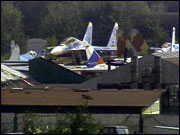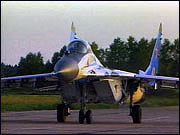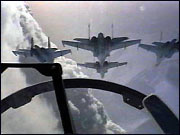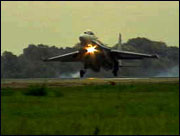 |

|
Russia's Best-Kept Secret
by Jay Miller
 I have a friend, Professor George Hopkins, who—after spending several weeks
touring Russia—once said to me, "If the Soviet Union didn't exist, the U.S.
Department of Defense would have to invent it." I couldn't agree more. I have a friend, Professor George Hopkins, who—after spending several weeks
touring Russia—once said to me, "If the Soviet Union didn't exist, the U.S.
Department of Defense would have to invent it." I couldn't agree more.
Having been to Russia three times over the past five years, I can tell you with
absolute certainty that the Russian Air Force—as we in the west once imagined
it—not only no longer exists as a viable defensive entity, it never existed as
one in the first place. Though in possession of enormous quantities of aircraft
and an equally sizable force of pilots and ground support personnel, the
military air service, as a world class combatant, has always been sorely
lacking in terms of discipline, wherewithal, and the massive infrastructure
required to support and maintain its enormous hardware fleet. In a country that
has difficulty getting even minute quantities of fresh produce to public
market, the latter failing comes as no surprise to even the most casual
observer.
 I've been privileged not only to tour Russian military bases, but also to spend
a considerable amount of time reviewing sophisticated flightworthy hardware
including the modestly capable but not particularly imaginative Mikoyan MiG-29
(NATO codename, Fulcrum), the world-class Sukhoi Su-27 (NATO codename
Flanker), and the definitive Sukhoi Su-35 (also bearing the NATO
codename Flanker) fighters. Though aesthetically appealing and capable
of extraordinary brute performance, these Mach 2-plus-capable fighters are
decidedly antiquated in an era now dominated by low-observables technology,
non-metallic structural materials, proactive attention to cockpit/pilot
interface, and a rapidly surfacing international military initiative in the
direction of UAVs (Unmanned Aerial Vehicles). I've been privileged not only to tour Russian military bases, but also to spend
a considerable amount of time reviewing sophisticated flightworthy hardware
including the modestly capable but not particularly imaginative Mikoyan MiG-29
(NATO codename, Fulcrum), the world-class Sukhoi Su-27 (NATO codename
Flanker), and the definitive Sukhoi Su-35 (also bearing the NATO
codename Flanker) fighters. Though aesthetically appealing and capable
of extraordinary brute performance, these Mach 2-plus-capable fighters are
decidedly antiquated in an era now dominated by low-observables technology,
non-metallic structural materials, proactive attention to cockpit/pilot
interface, and a rapidly surfacing international military initiative in the
direction of UAVs (Unmanned Aerial Vehicles).
 Conversely, the latest MiG and Sukhoi fighters, though offering a plethora of
mildly innovative and utilitarian features, are simply behind the technological
power curve...to the tune of about a decade. Though fighter design parity with
the west was temporarily achieved by the Russian aircraft industry during the
late 1950s and early 1960s with the advent of the midlife improvements to the
Mikoyan MiG-21 (NATO codename Fishbed), this status was
short-lived...and only accidentally achieved. As a point of interest, though
now well into its fourth decade of operational service, the MiG-21 remains
perhaps the single biggest threat to western combatants. This is due to its
ubiquity, its exemplary maneuvering performance throughout much of its flight
envelope, and its small size (which, by definition, brings it into the
contemporary realm of low-observable technology). Conversely, the latest MiG and Sukhoi fighters, though offering a plethora of
mildly innovative and utilitarian features, are simply behind the technological
power curve...to the tune of about a decade. Though fighter design parity with
the west was temporarily achieved by the Russian aircraft industry during the
late 1950s and early 1960s with the advent of the midlife improvements to the
Mikoyan MiG-21 (NATO codename Fishbed), this status was
short-lived...and only accidentally achieved. As a point of interest, though
now well into its fourth decade of operational service, the MiG-21 remains
perhaps the single biggest threat to western combatants. This is due to its
ubiquity, its exemplary maneuvering performance throughout much of its flight
envelope, and its small size (which, by definition, brings it into the
contemporary realm of low-observable technology).
 Not surprisingly, the U.S. Department of Defense has fought long and hard
during the post-World War Two era, the Cold War era, and now, the post-Cold War
era to maintain a public image of Russian technological and numerical
superiority. It had been, and in fact continues to be, a self-serving "spread
the gospel" mission that exploits public (aka taxpayers) fears while
concomitantly providing justification for continued—and exorbitant—government
defense expenditures. Not surprisingly, the U.S. Department of Defense has fought long and hard
during the post-World War Two era, the Cold War era, and now, the post-Cold War
era to maintain a public image of Russian technological and numerical
superiority. It had been, and in fact continues to be, a self-serving "spread
the gospel" mission that exploits public (aka taxpayers) fears while
concomitantly providing justification for continued—and exorbitant—government
defense expenditures.
I write not theoretically from having seen a magnified review of classified
reconnaissance imagery; not from having read third-party analytical verbiage
assembled via the exploitation of a broad spectrum of eclectic public domain
documentation; and not from having had access to reports that are the
privileged viewing of only a select few high-level government bureaucrats, but
rather from the perspective of one who has laid his hands on the metal, sat in
the cockpit, hung out with the pilots and ground support personnel, smelled the
combusted kerosene, and slept in working Russian's apartments rather than
overpriced hotels. I've been there, and I've done that, and I'm telling you
the Russian Air Force is a threat no more. In fact, it never was.
(continued)
Top Gun Home | In the Cockpit | Russian Air Force
Remembering Jeffrey Ethell | Pulling Cs & Gs | Links
| |
|